DATA SOURCE(S): 1,2,5,8,14
Common Name(s): Iroko, African teak
Scientific Name: Milicia excelsa and M. regia (formerly placed in the Chlorophora genus, see comments below)
Distribution: Tropical Africa
Tree Size: 100-130 ft (30-40 m) tall,
3-5 ft (1-1.5 m) trunk diameter
Average Dried Weight: 41.2 lbs/ft3 (660 kg/m3)
Specific Gravity (Basic, 12% MC): 0.56, 0.66
Janka Hardness: 1,190 lbf (5,310 N)
Modulus of Rupture: 14,080 lbf/in2 (97.1 MPa)
Elastic Modulus: 1,580,000 lbf/in2 (10.90 GPa)
Crushing Strength: 7,750 lbf/in2 (53.5 MPa)
Shrinkage: Radial: 3.3%, Tangential: 4.8%,
Volumetric: 8.8%, T/R Ratio: 1.5
Color/Appearance: Heartwood is usually a yellow to golden or medium brown, with color tending to darken over time. Pale yellow sapwood is clearly demarcated from the heartwood.
Grain/Texture: Iroko has a medium to coarse texture, with open pores and an interlocked grain.
Rot Resistance: Iroko is very durable, and is resistant to both rot and insect attack; it’s sometimes used as a substitute for genuine teak (Tectona grandis).
Workability: Generally easy to work, with the exception of its interlocked grain, which may cause some tearout during surfacing operations. Also, deposits of calcium carbonate are sometimes present, which can have a significant dulling effect on cutters. Iroko glues and finishes well.
Odor: No characteristic odor.
Allergies/Toxicity: Although severe reactions are quite uncommon, iroko has been reported as a sensitizer. Usually most common reactions simply include eye, skin, and respiratory irritation. Iroko can also cause other health effects in sensitive individuals, such as asthma-like symptoms, boils, and hypersensitivity pneumonitis. See the articles Wood Allergies and Toxicity and Wood Dust Safety for more information.
Pricing/Availability: Iroko is imported and available for a moderate price. Veneer can also be seen for sale, and is likewise affordably priced.
Sustainability: This wood species is not listed in the CITES Appendices, but is on the IUCN Red List. While Milicia excelsa is only listed as near threatened, M. regia is listed as vulnerable due to a population reduction of over 20% in the past three generations, caused by a decline in its natural range, and exploitation.
Common Uses: Veneer, flooring, furniture, cabinetry, boatbuilding, turned items, and other small specialty wood items.
Comments: Although the Milicia genus was first described back in 1909,[1]Sim, T. R. (1909) Forest Flora and Forest Researches of Portuguese East Africa: 97 for many decades iroko was placed in the Chlorophora genus, along with osage orange (as C. pomifera) and fustic (as C. tinctoria) —though these species are now placed in the Maclura genus. However, the Milicia genus was reinstated back in 1982,[2]Berg, C. C. (1982). The reinstatement of the genus Milicia Sim (Moraceae). Bulletin du Jardin botanique national de Belgique/Bulletin van de Nationale Plantentuin van Belgie, 225-229. with two recognized species (M. excelsa and M. regia). Both Milicia species are sold commercially as iroko, though M. excelsa is much more widespread and common throughout tropical Africa, with M. regia being restricted to a narrower region of forest areas within West Africa.
Iroko is sometimes marketed as a low-cost alternative to genuine teak, and is even sold under the name African teak, though that common name is much more commonly applied to afrormosia (Pericopsis elata)—but neither of these woods are botanically related to true teak. Nonetheless, the wood is stable, durable, and has an overall look that somewhat resembles teak.
Images: Drag the slider up/down to toggle between raw and finished wood.
A special thanks to Justin Holden for providing a wood sample, and also to Steve Earis for providing a wood sample and turned photos of this wood species.
Identification: See the article on Hardwood Anatomy for definitions of endgrain features.
Porosity: diffuse porous; growth rings indistinct
Arrangement: solitary and radial multiples
Vessels: large to very large, few to very few; tyloses common
Parenchyma: vasicentric, winged, lozenge, confluent, and banded
Rays: medium to wide width, normal spacing; rays may be just barely visible without magnification
Lookalikes/Substitutes: Afrormosia (Pericopsis elata) is another African hardwood that can bear a very close similarity to iroko and is also marketed as African teak. However, on average, afrormosia tends to have smaller, more numerous pores, and narrower rays.
Notes: None.
Related Content:
References[+]
| ↑1 | Sim, T. R. (1909) Forest Flora and Forest Researches of Portuguese East Africa: 97 |
|---|---|
| ↑2 | Berg, C. C. (1982). The reinstatement of the genus Milicia Sim (Moraceae). Bulletin du Jardin botanique national de Belgique/Bulletin van de Nationale Plantentuin van Belgie, 225-229. |

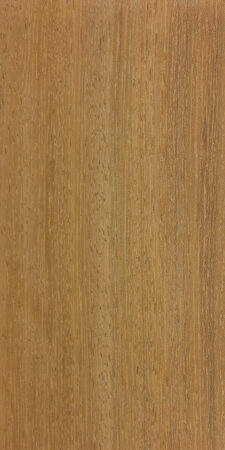
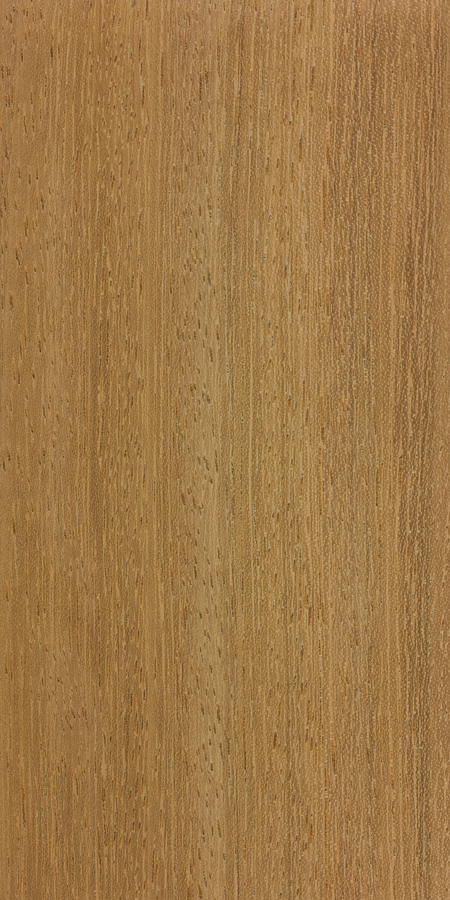
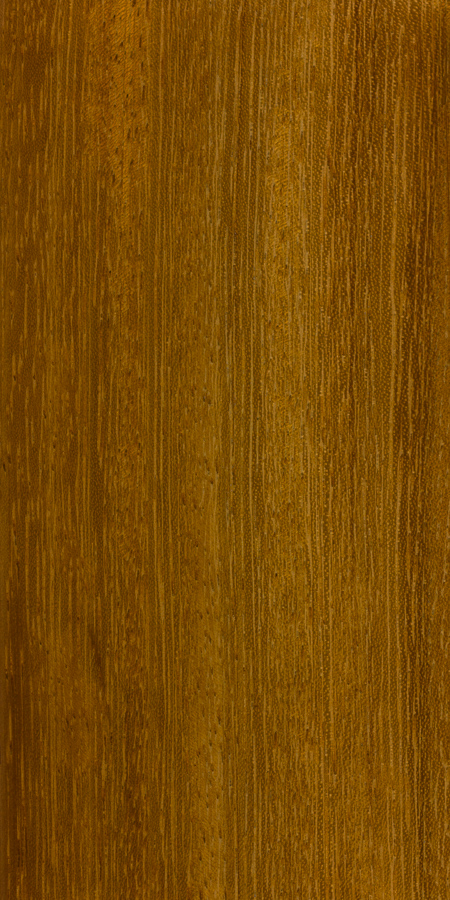
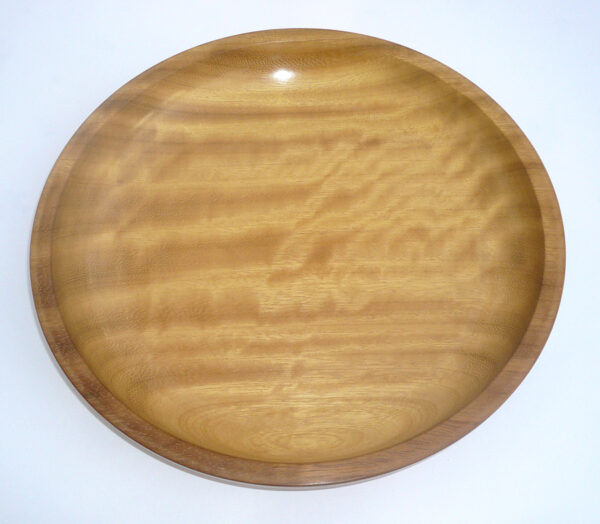
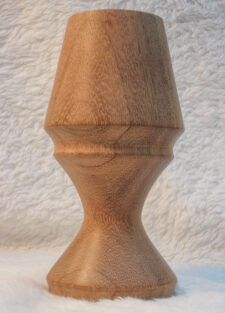
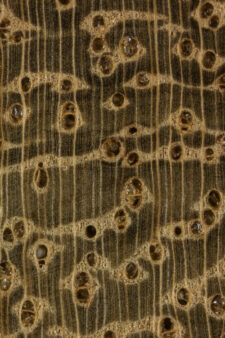

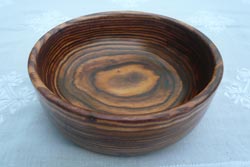
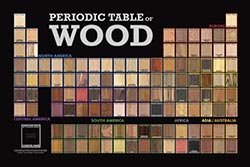





Hi, can anyone help me understand if it’s iroko or mahogany? I had a old scrap board in the woodshop and for a while I was told that was utile, then I started to plain and cut that board and my boss said that’s it’s iroko. I need to exactly know what wood it is in order to sell the instrument.
Thanks
That musical instrument could well be Iroko,the photo of the plank looks the wrong shade, I’ve machined through 300 tons of Iroko but a piece caught me out just 2 days ago…
Hi,
I’m an amateur woodturner and someone gave me a “scrap” piece of wood.
I forgot to take a picture of the rough turning square but it was unremarkable and didn’t thing much of it.
They told me:
I have an good olfactory sense and I don’t remember the wood having a smell.
The turning square was about 2″ wide, the toy top is a bit more larger than 1.5″.
Could it be iroko?
Thanks!
What is the ICC or UL# for IROKO wood?
I have an iroco plaque memorial for my late wife. It was treated with Devon Oil for preservation and was a lovely golden colour when we got it but over time (just over a year) it has really darkened and the engraved writing is harder to read. It was sent back to where we ordered it from for a refurb and we just got it back and are still not really happy with it. We were also never told the best way to maintain it. Any suggestions would be most welcome as we would love it a bit lighter as… Read more »
It’s very tricky since it’s such a sentimental piece. I am assuming it was either laser cut or CNC cut. Either way, there’s only a certain amount of depth to the cut before you start sanding away the actual design itself. I can see that perhaps that has already happened a little bit in the top areas with the butterfly wings. Generally, oil finishes tend to accelerate and worsen the darkening / patina process of most woods. I would avoid oil based finished for this reason. Water based finishes would have the least impact on color. You’d just have to… Read more »
Thank you Eric. So if I understand you right. If I try a water based varnish it might lighten it up. Am I correct? Wood bleach had been mentioned to me but I was reluctant before getting some good advice.
Regards
It won’t lighten anything if left as is. You’d have to sand down to raw wood, which is the tricky part if you end up sanding too aggressively and remove some of the design. The raw wood should be lighter in color. You could also try wood bleach on the raw wood, but you just need to be aware that you are losing some aspect of the color as you may not know how dramatically it will affect coloration. Whatever the course of action, it’s always best to test everything on a small area, preferably on the back of the… Read more »
Hello Eric,
Well the story lengthens. The place we got the plaque from has agreed to replace the whole thing. This throws up a question for me. They send the iroco plaque treated with Devon oil because the crematorium where it on display will only accept ‘natural’ plaques being in an area with nature. I don’t want the plaque to end up the same way again so my question is:
Would they know without close inspection if I coated it with a clear Matt water based varnish like Ronseal? Which I would hope would then stop the ingress/absorption of water.
I’d doubt there would be much visual difference between the two. The only time I could see issues coming up is with multiple coats. Not sure how many it would take, maybe three or more, but eventually you’d start to build up a visible surface film on the surface of the wood.
Thank you Eric. One final question. Will water based varnish adhere ok to oiled wood?
It would be very iffy to apply water based finish over an oil finish. Depends on the oil, and depends on the formulation of the water based finish, but in general, it’s a no-go.
Late to the party here – but if you are concerned at it darkening so much my advice, don’t have it produced in Iroko.
Iroko will only darken and darken in time; it will take a long time for this to silver away and only then if outside – certainly don’t oil it.
I would recommend good old reliable EOak for this if i was producing it.
POssibly with the lettering ‘filled’ with a high quality Ebony filler to make the text pop.
I hope you are pleased with whatever has been reproduced though of course !
Hello Eric
Need some advice on iroko how may cbm fit in 20ft container of round logs what’s best legth to cut
Andrew, this will heavily depend on log diameter and length but as a guide I would expect around 12-15m3 overall volume in log form personally.
Bought some quartersawn imported from Africa stair treads. The installer used a teak stain that day but it started to lighten a lot after a few months. Recently tried an all in one (prime-stain-seal) product but need to put second and third coats on still. The wood seems to be cracking in certain parts. Hairline cracks. A few pits. Been using wood putty to close. Was expecting them to last a long time but it seems not as durable as I imagined. summer cottage near the sea. Use dehumidifiers to keep the humidity levels low. About 30-35% upstairs and 40-45%… Read more »
RH of 30% seems pretty low, especially if the wood was not seasoned properly before being installed in your location. That could very well be the source of the checking, which shouldn’t necessarily affect longevity.
Ideally, you’d want to have the wood acclimatize to the humidity levels in your house for a few days/weeks before installing, and the best time to do this would be when the air is the driest, so in the United States that’s usually in the late fall.
Hello, thanks a lot for this amazing Web-site. We live in The Republic of Congo (Congo Brazzaville) and have plenty of Iroko (wenge) in our house. All kitchen bench-tops and doors, are made out of Iroko. Here in Brazzaville it is slightly more expensive than Akacia and used a lot for furniture. A very nice looking wood, indeed. I also have som old furmiture (from the 1930’s-40’s ) made of Wenge – which is no longer on the market. Again, thanks fro the data-base. / Carl
My experience of using Iroko outside is that it is not as rot resistant as, for example, Teak. I have found that when subjected to continuously damp conditions, such as a British Winter, it will rot from the end grain inwards. This is especially liable to happen if it is in contact with, for example, a softwood that has begun to rot. No amount of oil or coating prevents this from happening.
The governments allowing the cutting down of Iroko in west Africa are corrupt. I don’t think we should be importing Iroko. When you see the disappearance for yourself its very sad. These tress are not sustained. And they are so grand and beautiful like home tree in Avatar.
Very true, and it’s not like we don’t have similarly good or better alternatives such as maple, beech, birch or cherry which are grown in a far more responsible and sustainable manners. That’s why I won’t ever use these types of import lumbers from bad or suspicious sources unless I got it for free
Hello. I got a Kylix 27, built in England in 79, now situated in Copenhagen. It is painted. I just wonder, would it be possible to leave it without paint? I find the wood color very nice looking. I read that some people kept furniture in the garden for almost 30 years without oiling it, made from iroko. The furniture are still good. I will strip it for paint anyways, remove the crap that they put between the boards, and put in cotton tread with tar. It has not been maintained well the last 30 years. It was on land… Read more »
My boat has an iroko rub rail and cockpit coamings, which I think originally had Decks Olje applied but after 30 years without refinishing much of that has worn away. There is severe checking in the rubrail, and some in the coamings too (which were better maintained). I don’t recommend you leave your exterior iroko bare without some sort of paint or topcoat.
Forgot to mention: my boat has been in Seattle, USA, and British Columbia, Canada, so 9-10 months cool and drizzly each year, with 2-3 months of arid but not hot summer.
See is you can get WOODOC water Borne Sealers.
I was cutting a fairly short length on my bandsaw, the grain however, over the short length already cut, firmly closed up and trapped the blade. I had one terrific job extracting the blade, eventually it snapped, so it was a tough old hombre to cut. Cross grain is as easy as pastry cutting, but I ended up cutting many crossgrain actions to ease the length cutting. It didn’t make much difference to be fair. I finished the cut with a Japanese saw by hand, and planed the thing down, a much easier option…
when it close up its because it is not dried properly, called case hardening, if you suspect wood like that keep a wooden wedge handy and right after you start the cut add the wood wedge so it will not close up
about iroko odor, yes it has a good smell the same as i found it in teak while working with
any advice about gluing iroko i intent to make some glulam with polyurethane adhesive
We glued iroko with Tightbond III, which is water proof after curing. Worked great and resulted in the wood, not the joint, breaking on stress test.
Iroko is an excellent tone wood. I have constructed two mountain dulcimers from Iroko and they sound great. Good tonewoods do not need to be extremely dense; Koa is not and it is probably the best tonewood that you can get.
would it be suitable for a guitar neck?
It’s harder than some of the woods you see on mass produced guitar necks so it should be strong enough. I use it as a fingerboard on a fretless bass guitar with an African mahogany neck. Be ware, it’s interlocked grain make it a lot harder to work with than most tonewoods.
I made some guitar necks using it, they are amazing necks and I couldn’t stop tone testing them because they rang like a bell! I would recommend
Hi ,
If Iroko that is air dried is transported by ship in a container ,would the wood have any damage in any way due to the moisture content at sea .Will the planks go skew or change colour ,would like to know please
Does anyone know if this wood would be suitable as kitchen bench tops, if adequately varnished? I read the comments below about chopping boards, but the application I have in mind would mean that the wood is treated so that it is not exposed to water and other liquids. Any comments would be most welcome.
Iroko is more than appropriate for this application. The material is commonly used in creation of exterior timber gates, benches and decking with or without treatment as it is very durable. I’m a hardwood trader btw.
Bit late answering, better late than never? I have Iroko kitchen work tops, and all I ever do is oil, originally and every few years with boiled linseed, but if I spill olive oil, I wipe that around, so as not to waste it. I always use an old wooden bread board to cut on. The iroko worktop 20 years on still looks and feels amazing, with no chips/cracks/fading or damage of any kind. The oil does make the wood quite dark, which I like. Other oils might leave it paler?
I’m building my new home this year 2015. Someone recommend me Iroko for doors. I’m looking for advise that can i use Iroko for my doors in indoor and outdoor. I want to know should it behave good of shrinkage durabilty and termite resistant?
Looking for your advise..
Regards
Does anybody know whether Iroko works for xylophones or Marimbas? I know Ipe has a very resonant ring, but I’m reluctant to use it because of its endangered status.
Thanks. John Warner.
Murrumbateman. NSW. Australia
John,
Ipe: where did you see it is endangered?
We sell it to various destinations duly authorised by the Govt.
Thanks/Avner
Iroko is not a tone wood. Ipe is 2 or 3 times as hard as iroko.
Ipe is not endangered
The recent global run on ipe means that it is being overharvested almost everywhere it grows, leading to extensive forest degradation in Latin America. Unless you know that you are getting ipe from a conservation management forest (at least FSC certified but better if from a community management concession) you should avoid buying it.
the local Africans making a Djembe drum out of it and it consider as a good quality wood for that purpose.
there is a wood they call ‘balawood’ they make their local marimba keys out of it.
it looks like rosewood/cocobolo to me.
I have been making outdoor furniture with Iroko for 24 years
For exposed condititions I would say a Max of 100mm wide planks, preferably quarter sawn
I am working on a new construction of a large beautiful home, as a paint contractor for over 40 years of experience. The mill work contractor built exterior stairs steps and at the top a large top deck step/platform of Iroka wood, about four foot wide and five foot long, 1 1/2 thick, to fit into the metal stair Skelton. I researched what exterior stain would be best suited for application that not only sealed but you where able to walk on surface. Was informed by paint supplier that a product called Sikkens in whitch I am very familiar with… Read more »
Did you read the Sikkens can very carefully. Usually it is not recommended for horizontal surfaces ,says right on can. Other causes probably the wood not properly acclimated to site conditions, did you check it with a moisture meter ?. Also always need to coat all the surfaces of the wood and needs to be screwed down from underneath because it is a very strong wood. Good luck with repair it.
When we built our house over ten years ago, we had iroko wood work surfaces in the kitchen. Oiled with Danish oil, it looked fantastic and survived anything we could throw at it. I’d certainly use it again.
Lizzie
‘
Investigate a floor finish called Bona-really tough
I need to send a specification to an architect of how one would coat Iroka on a staircase to keep it from getting damaged. Do you have any recommendations. Also to the walls which will be Iroka veneer what coating should be used ?
Regards
Helen
Iv been recomended iroko for a project at home by carpenter i generally use but was just looking for adtional opinions and experiences. im basically re pebbledashing the front of our house as existing has had it, in the centre is what i think you would call a mock tudor frame decorative pattern that is presently made up of pine planks but these have rotted twisted and shrunk into oblivion. theyre about 2 inch think and are 6 3/4 inch to 7 3/4 wide and will be painted black to put match how it was built in the twentys. so… Read more »
Keith;
In answer to your question I would say no. It has an oil which can also be toxic and the open pores make a nice home for bacteria.
I use this is boat building and it is great for cockpits, rails, etc resisting rot and bugs but I would not use it near any food prep.
Hi Mike
Using IROKO in boat structures, can you also recommend using it for deck plank on Mahogany classic boat?
Is this wood suitable for chopping boards/butchers blocks…?
internal stresses can cause difficulties.mild steam bending possible.